Dedham
Sherman's
Hall (originally known as The English or Writing School) is a very old
private school building which stands opposite the church. The
tastefully decorative fascade features a fine sundial (see Aldeburgh
and Woodbridge
for more of these) replete with gold painted Roman numerals and a niche
below containing a lettered plinth and stone vase (not, however, as old
as they look...).
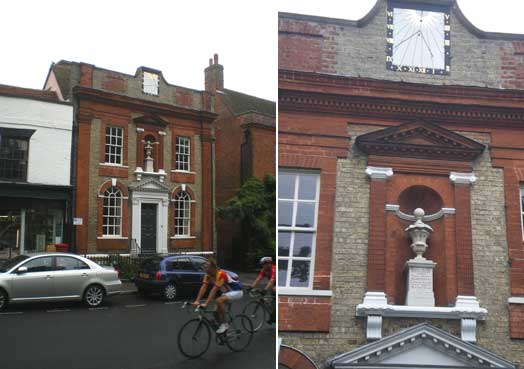
'Hasce Aedes
MDCCXXXV
erexit
Thomas
Sherman
+
MCMLXXVIII
Curator hered-
-itatis legavit
Marshall
Sisson
ARCHITECTUS'
'This temple (or 'These
rooms') 1735 were
erected by Thomas Sherman + 1978 Hereditary Legal Guardian Marshall
Sisson, Architect'.
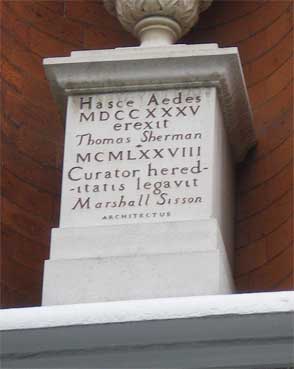
It is only
when one draws near to the railings around the front of the building
that the brickwork - or the way in which it has been defaced by past
pupils - is noticed. These extraordinary grafitti, some over 200 years
old, are quite readable on the whole and would repay some detailed
study and research to trace some of the people who created them. Some
of the lettering in copperplate script is a testimony to the superior
education provided by the Writing School. But did the Headmaster
encourage this apparent vandalism, continued over many years until it
became a tradition? Intriguing.
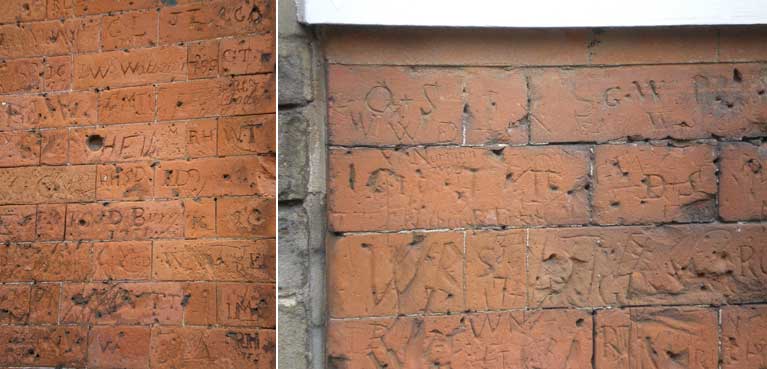
'G. TAYLOR
APIL 13 1777' (below, inside the scratched oval)
(Presumably once you start to scratch away at the redbrick, if you
don't notice that you've left the 'r' out of 'April', it's too late!
Admirable use of serifs by this boy.)
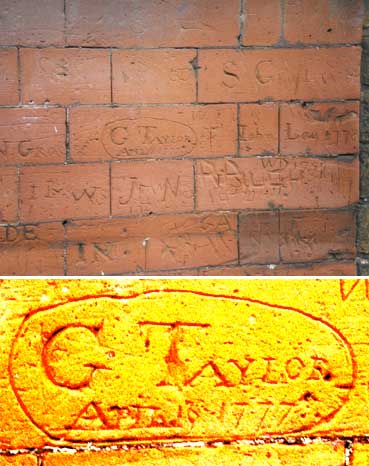 (Enhanced image)
(Enhanced image)
[UPDATE 22.2.2016: "Very
interesting article thank you. I have been researching my seventh Great
Grandfather, William Colchester, the schoolmaster for many years at
Sherman's Hall, and wonder if the lettering you mention 'S WC
1767' is Susanna and William Colchester. Would you know if this is the
case? I am happy for you to include my text on your page and have also
included a photo [see below] of some of the ‘graffiti’ from the
brickwork of the old Grammar School in Dedham which, as you can see,
bears the name ‘W Colchester’. This would be Susanna and William’s
son, also William, who was educated at the Grammar School along with
Cyprian, my sixth Great Grandfather. Interestingly, William (the
younger) did very well and went on to study maths at St John’s College,
Cambridge, graduating in 1764 and eventually becoming the Vicar at
Holton St Peter, Suffolk. The ‘graffiti’ if that is what it is, looks
so expertly carved, I can’t imagine a schoolboy being able to do this
and wonder if there was some other reason his name would have been
marked on the outside, maybe an olden times achievement board? It is
also very high up and would have had to be done with the aid of a
rather tall ladder! Lesley Jones." Many
thanks to Lesley for the image
and related information about her ancestors.]
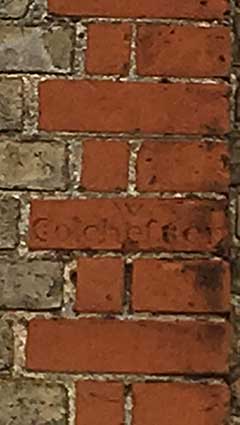
 Photo
courtesy Lesley Jones
Photo
courtesy Lesley Jones
We can do no better than to quote from
the
website of The Dedham Vale Society (see Links
for the full, informative article):
"Dedham High Street is a spectacular piece of architectural stage
scenery. Few of the frontages that present themselves to the street are
anything like as old as the structures that lurk behind; most of them
received a dramatic facelift in times of Georgian prosperity, in order
to ‘modernise’ the essentially medieval fabric of
the village. There is no more striking example of this tendency than a
house right at the heart of the village, opposite the parish church.
This is the house variously known as Sherman’s Hall,
Sherman’s House or just plain Sherman’s.
It is worth saying a little about the Sherman family, who built the
house and who have had a remarkable influence well beyond Dedham, in
the New World. The first known Sherman to settle in Dedham was Henry S.
Sherman, who arrived in 1532 and established a successful cloth
business. This was one of many such businesses established on the back
of the wool trade, which had made this one of the wealthiest parts of
the country. His sons Edmund and Henry were amongst the first governors
of the Grammar School in Dedham, which was founded in 1571, and Edmund
also founded the English or Writing School at Sherman’s. ...
In the 1870s a Commission was set up to look into the running of the
Dedham schools. It recommended that a new elementary school should be
built, and that the remit of the Grammar School should be expanded to
meet the educational requirements of the middle class, as well as
offering an education to poorer children showing academic promise. And
so in 1873 the English School at Sherman’s closed. However, a
tangible reminder of the long years of school use can still be seen in
the many initials carved by Georgian and Victorian schoolboys in the
soft red brickwork of the façade.
The elaborate brick frontage that we see today is the result of
extensive alterations carried out in 1730-31. The ‘principal
undertaker’ for this work was Mr Nicholas Freeman, who also
oversaw the rebuilding of the Grammar School in the same year. The
total cost of the remodelling of Sherman’s was £533
2s and fourpence half-penny. While this sum included provision for
internal remodelling, this was relatively modest in character; the
chief display was reserved for the facade, as if wishing to outdo the
Grammar School.
This front façade is one of the great showpieces of the
village and the county. It is a narrow, busy frontage which manages to
accommodate all three of the principal classical Orders as well as a
host of other architectural details. The façade is framed by
a giant order of Doric pilasters surmounted by a dentil cornice, all in
beautifully cut and jointed soft red brick. There is a fine timber door
case with Corinthian pilasters and pediment. Above this there is an
arched niche, also pedimented, and framed by Ionic pilasters, all in
the same red brick. The niche now contains an urn, designed by Quinlan
Terry and added in 1980. Crowning the elevation is a high parapet,
swept up to accommodate a large sundial. There are four large sash
windows, with typical early Georgian thick-section ovolo moulded
glazing bars, and red brick surrounds and aprons.
The urn in the niche commemorates the Sherman family and the fact that
Marshall Sisson, architect, gave the house to the National Trust in
1979. Sisson had moved to the village in 1934; like Raymond Erith he
was (after early experiments with modernism) most at home working in
the classical idiom. Also like Erith (and Sir Alfred Munnings), he was
an original committee member of the Dedham Vale Society, which had been
formed in 1937. Mrs Sisson, herself an accomplished artist and
musician, was Secretary to the committee."
Andrew
Derrick, February 2005, Dedham
Vale Society
[UPDATE
2.6.2016: 'I read with interest your page about Dedham Grammar School.
I was in Dedham at the weekend looking at the graffiti on the walls. My
four times Great Grandfather, John Tayler, attended the Writing School
run by William Colchester. I had hoped to find his name on the
brickwork but sadly couldn’t! I know he was there though, as we have a
couple of sheets of copperplate writing he did with the school’s name
on and signed by him. They are dated 29 November 1760 and 24 April
1761. [They appear on the web page linked below.] Lesley Jones may be
interested, too [see update 22.2.2016 above].
I don’t think he was related to Grimwood Tayler, who you mention. John
always spelled Tayler with an ‘e’ and in my family history research I
haven’t found a link. Anyway I have a page about him (with a picture)
on my website here.
Many thanks. Rob Webb' Many thanks
to Rob for getting in touch and for adding to the story of this
fascinating institution.]
Round the
corner from the school house in a tiny lane is a dated roundel (once
again, suspiciously modern-looking and well maintained) reading:
'S
WC
1767'
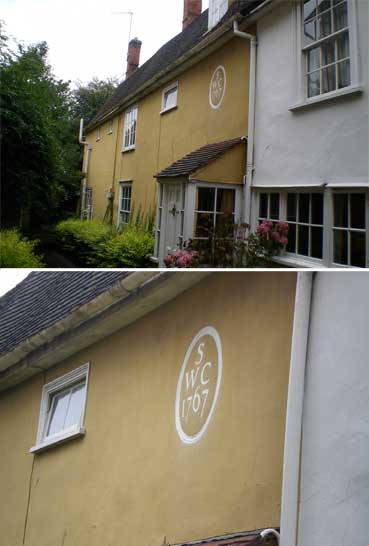
See the update from Lesley Jones above for a possible solution to the
intials: her ancestors 'Susanna and William
Colchester'.
Walking down the High
Street towards the
Dedham Arts and Crafts Centre is Well House (named on the front door)
with a stone plaque high above the porch:
'THOMAS
GRIMWOOD
Hujus Scholae
Magister 1732'
This
translates as 'Thomas Grimwood: Master of this School 1732' (assuming
'Hujus' is 'Huius' meaning 'of this').
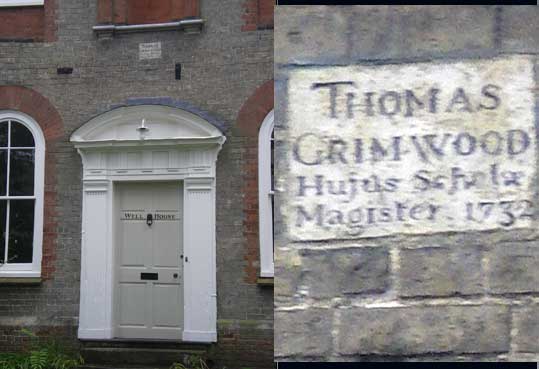
This small
stone plaque has the genuine air of antiquity about it. There is a town
pump nearby. Here the stream passes in front of the buildings
and gardens so that access to them is via small bridges. Over the road
from Well House is Brook House marking the place where the water passes
under the High Street and past the rear gardens eventually to flow into
the River Stour.
In School Lane, to the west of High Street.
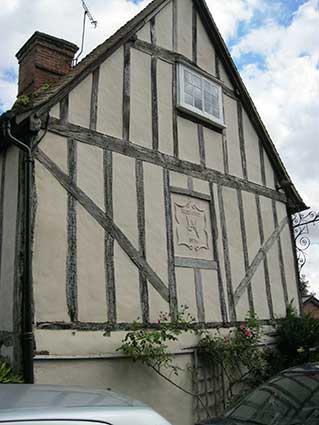
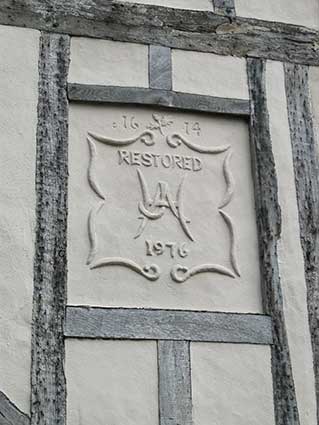 2015 images
2015 images
'16 ... 14
restored
JAH[?]
1976'
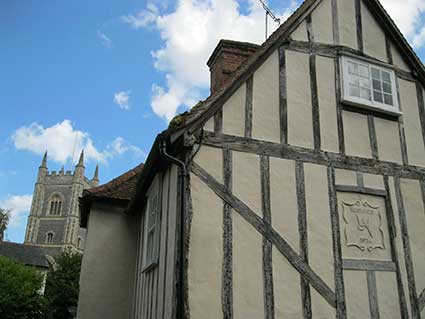
The nearness of Dedham Church is shown by the image above...
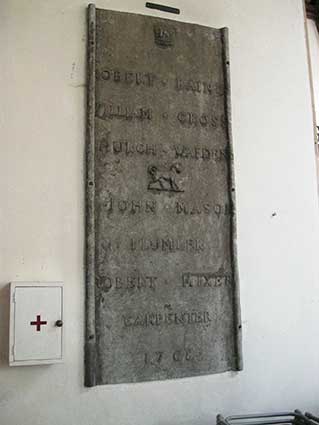
As with most churches there are many inscriptions of which these
are but two.
'ROBERT BAINE
WILLIAM CROSS
CHURCH WARDENS
JOHN MASON
PLUMBER
ROBERT MIXER
CARPENTER
1768'

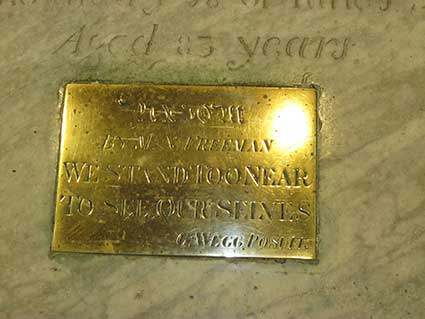
'Here lies Interr'd the Body of
Mr. JOHN FREEMAN;
who departed this Life ye. 9th.
of November, 1729. Aged 61 years.
Here Also lies the Body of
NICHOLAS FREEMAN Gen.
who died ye 18th of June 1747
Aged 83 years.'
and on the brass plate:
'[?]
BY MR. V. FREEMAN
WE STAND TOO NEAR
TO SEE OURSELVES
G:WEGG POSUIT.'



 (Enhanced image)
(Enhanced image)
 Photo
courtesy Lesley Jones
Photo
courtesy Lesley Jones


 2015 images
2015 images


